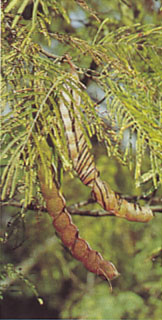
|
|
| Growing Anadenanthera colubrina - Cebil, Villca - |
|
Anadenthera colubrina grows as a tree up to 20 meters in height. It is often found with knotty or thorny bark. Its leaves are of the mimosa type, a little like fern fronds. It has white to pale yellow spherical flowers, which form clusters and are covered in fine white hairs. The flat, burgandy-brown seeds are formed in pea-like pods, up to 35cm in length and containing anything up to 10 seeds each. It grows in open grassland throughout the Southern Andes. The climate is tropical to subtropical. Fresh seeds germinate very easily, but seeds sold for entheogenic purposes are likely be too old and are unlikely to germinate. It is important to buy only seeds sold as 'viable' if you intend to grow this species. Search for viable seeds on Google. The seeds should be pre-soaked in sterile water for 24 hours. Boil the water and leave to cool to room temperature before submerging the seeds. The seeds and seedlings are very prone to rot so it is best to germinate in a medium containing no organic matter. Sharp horticultural sand, perlite and vermiculite are all suitable. Ideally, these should be sterilised first too. It is also possible to germinate these seeds between damp tissue paper in zip-lock bags. It has also been suggested to me to germinate by submerging the seeds in fresh water and changing the water frequently until germination has occurred. Regardless of which technique is used, it is important that all water is sterile. The seeds require a minimum temperature of 22°C to germinate, so a heated propagator, or other constant source of heat is essential. If you are using perlite/vermiculite/sand, plant the seeds in pots or seed trays about 1cm below the surface, and water lightly with a watering can or spray with a pump bottle. Make sure the growing medium is moist throughout, but not wet. Leave to stand for a while so any excess water can drain through the holes in the bottom. Then place the pots or trays in the propagator in a bright area away from direct sunlight. It is important that the pots/trays receive daily ventilation to prevent mould forming. You may need to water daily, or every few days, depending on the circumstances. Mould, and 'Damping-Off' fungus can be prevented (and cured) by watering with a half or quarter strength solution of Cheshunt Compound (this can be purchased in most garden centres). If you do not have access to Cheshunt Compound, sulphur, powdered chalk, or powdered limestone will help a little. The seeds should germinate within a week, although this may take longer in some circumstances. Once the seedlings are showing through the soil, gradually acclimatise them to drier conditions, by providing progressively more ventilation. Water sparingly but regularly. Let the growing medium become almost dry between waterings, and stay alert for the appearance of mould, as this will kill seedlings very quickly. At the other extreme, you should ensure that the conditions are not too hot, as they will quickly wilt and die. I have lost several batches of these seedlings because of hasty removal from the propagator. Because the growing medium has no organic components, you should also start feeding with fertaliser. Begin by occasionally adding fertaliser to the water at 1/4 recomended strength, then 1/2 recomended strength, etc. Once the seedlings are big enough to handle safely, or are becoming overcrowded, they can be potted up individually. For the first year they will grow slowly, and still require a free draining soil, such as 50% cactus compost, 50% perlite. Alternatively, ready-bagged bonsai compost would probably be suitable. In their second year re-pot in fresh compost. This time it can be very rich in organic components, but must still be fairly free draining. Something like 50% peat substitute, 25% coconut coir and 25% perlite, would probably be suitable. They should soon begin to grow more vigorously. A 2cm layer of gravel or broken crocks (terracotta pots) in the base of the pot will provide extra drainage. Also, a 1cm layer of cactus top dressing or fish tank gravel on the surface will help to prevent the perlite from floating to the surface, cut down on excessive evaporation, prevent the soil compacting when watering from above, and it looks nice too. They like full, warm sun and a free draining soil. They will not tolerate being waterlogged, and they are likely to withstand only a very light frost. These plants will die if subjected to sub-zero temperatures, particularly if wet. As Anadenanthera colubrina is a tropical to subtropical tree, it should really be grown in a greenhouse or conservatory when cultivated in temperate regions.
|
|
Related
Articles :
|
|
| Email
This Article To A Friend - Print
This Article Articles can be E-mailed to a friend and you can get a printable version of the article IMPORTANT: We provide all information for educational purposes only, and endorse or recommend nothing here. A special thanks to Keith for all his support and insight. |
|
